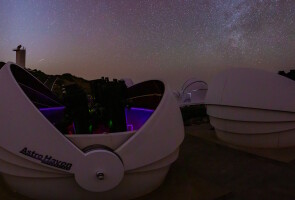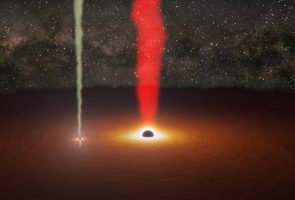In the latest issue of the journal Nature, an international team including astronomers from University of Turku reveal the origin of a thermonuclear supernova explosion. Strong emission lines of helium and the first detection of such a supernova in radio waves show that the exploding white dwarf star had a helium-rich companion.
Thermonuclear (Type Ia) supernovae are important for astronomers since they are used to measure the expansion of the Universe. However, the origin of these explosions has remained an open question. While it is established that the explosion is that of a compact white dwarf star somehow accreting too much matter from a companion star, the exact process and the nature of the progenitor is not known. The new discovery of supernova SN 2020eyj established that the companion star was a so-called helium star that had lost much of its material just prior to the explosion of the white dwarf.
“Once we saw the signatures of strong interaction with the material from the companion we tried to detect it also in radio emission”, explains Erik Kool, post-doc at the Department of Astronomy at Stockholm University and lead author of the paper. “The detection in radio is actually the first one of a Type Ia supernova – something astronomers have tried to do for decades.”
SN 2020eyj was discovered by the Zwicky Transient Facility camera on Palomar Mountain and was followed with a number of facilities including the Nordic Optical Telescope (NOT) on La Palma, the large Keck telescope on Hawai’i and the electronic Multi-Element Radio Linked Interferometre Network (e-MERLIN) which is an array of seven radio telescopes in Great Britain.
Supernova 2020eyj was also extremely bright at infrared wavelengths rivaling some of the brightest supernovae observed at these wavelengths. This brightness was interpreted as thermal emission from interstellar dust particles mixed in the material surrounding the supernova.
“The radio, optical and infrared observations are all consistent with the companion star losing a substantial amount of mass prior to the explosion of the white dwarf. This exciting discovery provides better understanding of explosions of white dwarfs as supernovae used for cosmological measurements” according to Prof. Seppo Mattila, Department of Physics and Astronomy at University of Turku who was a co-author of the paper with his main contribution in the interpretation of the infrared and radio observations.
The paper A radio-detected Type Ia supernova with helium-rich circumstellar material is published in Nature and is led by Erik Kool from the Department of Astronomy at Stockholm University and describes the first radio detection of a Type Ia supernova. The work involved researchers from institutes across the world, including University of Turku, Caltech, Weizmann Institute, IAA-CSIC, NAOJ, Macquarie University, and Trinity College Dublin.
Artist impression of the double star system with a compact white dwarf star accreting matter from a helium-rich donor companion, surrounded by dense and dusty circumstellar material. It was the interaction of the exploded star and the material left over from this companion that gave rise to the strong radio signal, the conspicuous helium lines in the optical spectra and the infrared emission from SN 2020eyj.
Photo and video: Adam Makarenko/W. M. Keck Observatory





